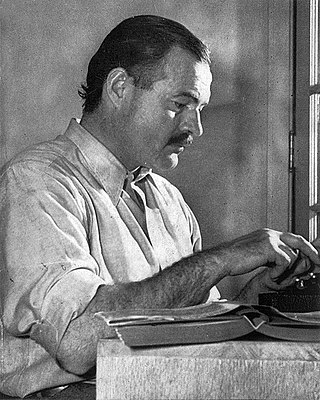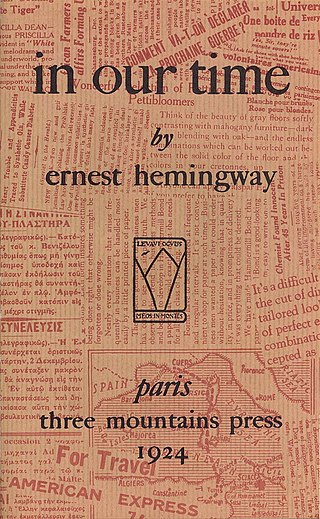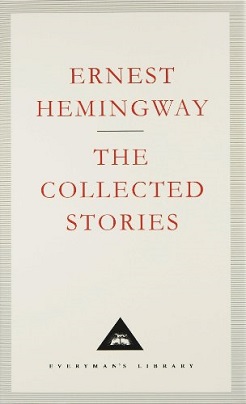
Ernest Miller Hemingway was an American novelist, short-story writer, and journalist. His economical and understated style—which included his iceberg theory—had a strong influence on 20th-century fiction, while his adventurous lifestyle and public image brought him admiration from later generations. Hemingway produced most of his work between the mid-1920s and the mid-1950s, and he was awarded the 1954 Nobel Prize in Literature. He published seven novels, six short-story collections, and two nonfiction works. Three of his novels, four short-story collections, and three nonfiction works were published posthumously. Many of his works are considered classics of American literature.

In Our Time is the title of Ernest Hemingway's first collection of short stories, published in 1925 by Boni & Liveright, New York, and of a collection of vignettes published in 1924 in France titled in our time. Its title is derived from the English Book of Common Prayer, "Give peace in our time, O Lord".

The Complete Short Stories of Ernest Hemingway: The Finca Vigía Edition, is a posthumous collection of Ernest Hemingway's short fiction, published in 1987. It contains the classic First Forty-Nine Stories as well as 21 other stories and a foreword by his sons.
Nicholas Adams is a fictional character, the protagonist of two dozen short stories and vignettes written in the 1920s and 1930s by American author Ernest Hemingway. Adams is partly inspired by Hemingway's own experiences, from his summers in Northern Michigan at his family cottage to his service in the Red Cross ambulance corps in World War I. The first of Hemingway's stories to feature Nick Adams was published in his 1925 collection In Our Time, with Adams appearing as a young child in "Indian Camp", the collection's first story.

The iceberg theory or theory of omission is a writing technique coined by American writer Ernest Hemingway. As a young journalist, Hemingway had to focus his newspaper reports on immediate events, with very little context or interpretation. When he became a writer of short stories, he retained this minimalistic style, focusing on surface elements without explicitly discussing underlying themes. Hemingway believed the deeper meaning of a story should not be evident on the surface, but should shine through implicitly.

"Big Two-Hearted River" is a two-part short story written by American author Ernest Hemingway, published in the 1925 Boni & Liveright edition of In Our Time, the first American volume of Hemingway's short stories. It features a single protagonist, Hemingway's recurrent autobiographical character Nick Adams, whose speaking voice is heard just three times. The story explores the destructive qualities of war which is countered by the healing and regenerative powers of nature. When it was published, critics praised Hemingway's sparse writing style and it became an important work in his canon.

Ernest Hemingway: The Collected Stories is a posthumous collection of Hemingway's short fiction, published in 1995. Introduced by James Fenton, it is published in the UK only by Random House as part of the Everyman Library. The collection is split in two parts.

Hemingway's Adventures of a Young Man is a 1962 American adventure film directed by Martin Ritt based on Ernest Hemingway's semi-autobiographical character Nick Adams, and featuring Richard Beymer as Adams. A.E. Hotchner wrote the screenplay, originally calling the film Ernest Hemingway's "Young Man". The cast includes Diane Baker, Jessica Tandy, Ricardo Montalbán, Eli Wallach, Arthur Kennedy and Paul Newman. It was released in July 1962.

“The Three-Day Blow” is a short story written by Ernest Hemingway, published in the 1925 New York edition of In Our Time, by Boni & Liveright. The story is the fourth in the collection to feature Nick Adams, Hemingway's autobiographical alter ego.

Ernest Hemingway (1899–1961) was an American novelist, short-story writer, journalist, and sportsman. His economical and understated style—which he termed the iceberg theory—had a strong influence on 20th-century fiction. Many of his works are considered classics of American literature.

"Indian Camp" is a short story written by Ernest Hemingway. The story was first published in 1924 in Ford Madox Ford's literary magazine Transatlantic Review in Paris and republished by Boni & Liveright in Hemingway's first American volume of short stories In Our Time in 1925. Hemingway's semi-autobiographical character Nick Adams—a child in this story—makes his first appearance in "Indian Camp", told from his point of view.

“The End of Something” is a short story written by Ernest Hemingway, published in the 1925 New York edition of In Our Time, by Boni & Liveright. The story is the third in the collection to feature Nick Adams, Hemingway's autobiographical alter ego.

"The Battler" is a short story written by Ernest Hemingway, published in the 1925 New York edition of In Our Time, by Boni & Liveright. The story is the fifth in the collection to feature Nick Adams, Hemingway's autobiographical alter ego.

The Nick Adams Stories is a volume of short stories written by Ernest Hemingway published in 1972, a decade after the author's death. In the volume, all the stories featuring Nick Adams, published in various collections during Hemingway's lifetime, are compiled in a single collection. The Nick Adams Stories includes 24 stories and sketches, eight of which were previously unpublished. Some of Hemingway's earliest work, such as "Indian Camp," as well as some of his best known stories, such as "Big Two-Hearted River," are represented.

"The Doctor and the Doctor's Wife" is a short story by Ernest Hemingway, published in the 1925 New York edition of In Our Time, by Boni & Liveright. The story is the second in the collection to feature Nick Adams, Hemingway's autobiographical alter ego. "The Doctor and the Doctor's Wife" follows "Indian Camp" in the collection, includes elements of the same style and themes, yet is written in counterpoint to the first story.

"The Revolutionist" is an Ernest Hemingway short story published in his first American volume of stories In Our Time. Originally written as a vignette for his earlier Paris edition of the collection, titled in our time, he rewrote and expanded the piece for the 1925 American edition published by Boni & Liveright. It is only one of two vignettes rewritten as short stories for the American edition.

"My Old Man" is a short story written by Ernest Hemingway, published in his 1923 book Three Stories and Ten Poems, which published by a small Paris imprint. The story was also included in his next collection of stories, In Our Time, published in New York in 1925 by Boni & Liveright. The story tells of a boy named Joe whose father is a steeplechase jockey, and is narrated from Joe's point-of-view.

"Out of Season" is a short story written by Ernest Hemingway, first published in 1923 in Paris in the privately printed book, Three Stories and Ten Poems. It was included in his next collection of stories, In Our Time, published in New York in 1925 by Boni & Liveright. Set in Cortina d'Ampezzo, Italy, the story is about an expatriate American husband and wife who spend the day fishing, with a local guide. Critical attention focuses chiefly on its autobiographical elements and on Hemingway's claim that it was his first attempt at using the "theory of omission".

"On the Quai at Smyrna" is a short story written by Ernest Hemingway, first published in the 1930 Scribner's edition of the In Our Time collection of short stories, then titled "Introduction by the author". Accompanying it was an introduction by Edmund Wilson. Considered little more than a vignette, the piece was renamed "On the Quai at Smyrna" in the 1938 publication of The Fifth Column and the First Forty-Nine Stories. When In Our Time was reissued in 1955, it led with "On the Quai at Smyrna", replacing "Indian Camp" as the first story of the collection.

"Mr. and Mrs. Elliot" is a short story written by Ernest Hemingway. The story was first published in The Little Review in 1924 and republished by Boni & Liveright in Hemingway's first American volume of short stories, In Our Time, in 1925.








